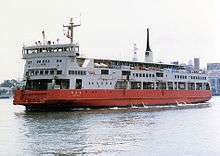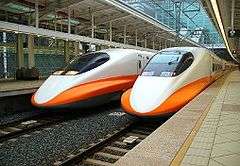Japanese National Railways
|
| |
| Locale | Japan |
|---|---|
| Dates of operation | 1949–1987 |
| Predecessor | Japanese Government Railways |
| Successor | Japan Railways Group |
| Track gauge |
1,067 mm (3 ft 6 in), 1,435 mm (4 ft 8 1⁄2 in) |
| Length |
21,421.1 km (13,310.5 mi) (at peak, 1981) |
| Headquarters | Tokyo |
Japanese National Railways (日本国有鉄道 Nihon Kokuyū Tetsudō), abbreviated Kokutetsu (国鉄) or "JNR", was the body which operated the national railway network of Japan from 1949 to 1987.
Network
Railways
As of June 1, 1949, the date of establishment of JNR, it operated 19,756.8 km (12,276.3 mi) of narrow gauge (1,067 mm (3 ft 6 in)) railways in all 46 prefectures of Japan (Okinawa, the 47th prefecture, returned to the Japanese administration in 1972 but no JNR line existed in Okinawa). This figure expanded to 21,421.1 km (13,310.5 mi) in 1981 (excluding Shinkansen), but later reduced to 19,633.6 km (12,199.8 mi) as of March 31, 1987, the last day of JNR.[1]
JNR operated both passenger and freight services.

Shinkansen, the world's first high-speed railway was debuted by JNR in 1964. By the end of JNR in 1987, four lines were constructed:
- Tōkaidō Shinkansen
- 515.4 km (320.3 mi), completed in 1964
- Sanyō Shinkansen
- 553.7 km (344.1 mi), completed in 1975
- Tōhoku Shinkansen
- 492.9 km (306.3 mi), as of 1987
- Jōetsu Shinkansen
- 269.5 km (167.5 mi), completed in 1982
Buses

JNR operated bus lines as feeders, supplements or substitutions of railways. Unlike railway operation, JNR Bus was not superior to other local bus operators. The JR Bus companies are the successors of the bus operation of JNR.
Ships
JNR operated ferries to connect railway networks separated by sea or to meet other local demands:
- Kanmon Ferry (discontinued in 1964)
- Shimonoseki Station (Shimonoseki, Yamaguchi) – Mojikō Station (Kitakyūshū, Fukuoka)
- Miyajima Ferry
- Miyajimaguchi Station (Ōno, Hiroshima) – Miyajima Station (Miyajima, Hiroshima)
- Nihori Ferry (discontinued in 1982)
- Nigata Station (Kure, Hiroshima) – Horie Station (Matsuyama, Ehime)

- Ōshima Ferry (discontinued in 1976)
- Ōbatake Station (Yanai, Yamaguchi) – Komatsukō Station (Suō-Ōshima, Yamaguchi)
- Seikan Ferry
- Aomori Station (Aomori, Aomori) – Hakodate Station (Hakodate, Hokkaidō)
- Ukō Ferry
- Uno Station (Tamano, Okayama) – Takamatsu Station (Takamatsu, Kagawa)
Out of three routes assigned to JR companies in 1987, only the Miyajima Ferry remains active as of 2010.
Unions
A number of unions represented workers at JNR, including the National Railway Workers' Union (Kokuro), the National Railway Locomotive Engineers' Union (Doro), and Doro-Chiba, a break-away group from Doro.
History

The term Kokuyū Tetsudō "state-owned railway" originally referred to a network of railway lines operated by 17 private companies that were nationalized following the Railway Nationalization Act of 1906 and placed under the control of the Railway Institute. Later, the Ministry of Railways and the Ministry of Transportation and Communications took over control of the network. The ministries used the name Japanese Government Railways (JGR) to refer their network in English. During World War II, many JGR lines were dismantled to supply steel for the war effort.
On June 1, 1949 by a directive of the U.S. General HQ in Tokyo, JGR was reorganized into Japanese National Railways, a state-owned public corporation. JNR enjoyed many successes, including the October 1, 1964 inauguration of high-speed Shinkansen service along the Tōkaidō Shinkansen line. However, JNR was not a state-run corporation; its accounting was independent from the national budget. Rural sections without enough passengers began to press its management, pulling it further and further into debt.
By 1987, JNR's debt was over ¥27 trillion ($280 billion at 2009 exchange rates) and the company was spending ¥147 for every ¥100 earned.[2] By an act of the Diet of Japan, on April 1, 1987 JNR was privatized and divided into seven railway companies, six passenger and one freight, collectively called the Japan Railways Group or JR Group. Long-term liabilities of JNR were taken over by the JNR Settlement Corporation. That corporation was subsequently disbanded on October 22, 1998, and its remaining debts were transferred to the national budget's general accounting.[3] By this time the debt has risen to ¥30 trillion ($310 billion in 2009 dollars).
JNR dismissal lawsuit
Many lawsuits and labor commission cases were filed over the decades from the privatization in 1987. Kokuro and the National Railway Locomotive Engineers' Union (Zendoro), both prominent Japanese railway unions, represented a number of the JNR workers.
Lists of workers to be employed by the new organizations were drawn up by JNR and given to the JR companies. There was substantial pressure on union members to leave their unions, and within a year, the membership of the National Railway Workers' Union (Kokuro) fell from 200,000 to 44,000. Workers who had supported the privatization, or those who left Kokuro, were hired at substantially higher rates than Kokuro members.[4]
There was a government pledge that no one would be "Thrown out onto the street",[5] and so unhired workers were classified as "needing to be employed" and were transferred to the JNR Settlement Corporation, where they could be assigned for up to three years.[6] Around 7,600 workers were transferred in this way, and around 2,000 of them were hired by JR firms, and 3,000 found work elsewhere. Mitomu Yamaguchi, a former JNR employee from Tosu in Saga prefecture who had been transferred to the JNR Settlement Corporation, later stated that their help in finding work consisted of giving him photocopies of recruitment ads from newspapers.[5] This period ended in April 1990, and 1,047 were dismissed. This included 64 Zendoro members and 966 Kokuro members.[7][8]
Twenty-three years after the original privatization, on June 28, 2010, the Supreme Court settled the dispute between the workers and the Japan Railway Construction, Transport and Technology Agency, the successor body to the JNR Settlement Corporation. The agency said it would pay 20 billion yen, approximately 22 million yen per worker, to 904 plaintiffs. However, as the workers were not reinstated, it was not a full settlement.[9]
Baseball team
Between 1950 and 1965, JNR indirectly owned a professional baseball team named Kokutetsu Swallows (国鉄スワローズ Kokutetsu Suwarōzu). Swallow was a symbol of JNR as it is the English equivalent of the Japanese Tsubame, the name of a deluxe train operated by JNR in the 1950s. The Kokutetsu Swallows were the predecessors of present-day Tokyo Yakult Swallows.
Accidents and criminal incidents
Accidents
JNR as a public corporation (from 1949 to 1987) experienced five major accidents (including two shipwrecks of railway ferries) with casualties more than 100:
- Sakuragichō train fire
- A train fire at Sakuragichō Station in Yokohama on April 24, 1951 killed 106.
- Toya Maru disaster
- A Seikan ferryboat sank off Hakodate killing 1,155 in a typhoon storm on September 26, 1954.
- Shiun Maru disaster
- An Ukō ferryboat collided with a fellow boat in a dense fog and sank killing 168 on May 11, 1955.
- Mikawashima rail crash
- A three-train collision near Mikawashima Station in Tokyo on May 3, 1962 killed 160.
- Yokohama rail crash
- A three-train collision near Tsurumi Station in Yokohama on November 9, 1963 killed 161.
Criminal incidents
In its very early days as a public corporation, JNR experienced a series of mysterious incidents as follows. Although the police at that time treated them as terrorism by the communists, doubts have been raised as to the validity of this conclusion.
- Shimoyama incident
- The dismembered body of JNR President Sadanori Shimoyama was found on a railway track on July 5, 1949. (The possibility of non-criminal suicide has not been ruled out.)
- Mitaka incident
- A train running without crew crashed into passengers and killed six people on July 15, 1949.
- Matsukawa incident
- A train was derailed because of destroyed track and three crew were killed on August 17, 1949.
In later years, JNR was a target of radical leftists. On October 21, 1968, groups of extremist students celebrating "International Antiwar Day" occupied and vandalized Shinjuku Station in Tokyo.[10][11] They criticized JNR's collaboration in the Vietnam War by operating freight trains carrying jet fuel for U.S. military use. On November 29, 1985, militants supporting a radical sect of JNR's labor union objecting to the privatization of JNR damaged signal cables at 33 points around Tokyo and Osaka to halt thousands of commuter trains and then set fire to Asakusabashi Station in Tokyo.[12]
As such, relationships with labor unions were always a difficult problem for JNR. Since public workers were prohibited to strike, they carried out "work-to-rule protests" that caused trains to be delayed. On March 13, 1973, train delays caused by such protests resulted in a riot of angered passengers at Ageo Station in Saitama Prefecture.[13] From November 26, 1975 to December 3, 1975, major labor unions of JNR conducted an eight-day-long illegal "strike for the right to strike", which resulted in a total defeat of the unions.[14]
See also
- Japan Railways locomotive numbering and classification
- SoftBank Telecom – former Japan Telecom, an affiliated company of JNR established in 1984
References
- ↑ Ishino, Tetsu et al. (eds.) (1998). 停車場変遷大事典 国鉄・JR編 [Station Transition Directory - JNR/JR] (in Japanese) I. Tokyo: JTB Corporation. pp. 289, 305, 310. ISBN 4533029809.
- ↑ http://www.jrtr.net/jrtr22/pdf/F23_Kakumoto.pdf
- ↑ 日本国有鉄道清算事業団. デジタル大辞泉 (Digital Daijisen) (in Japanese). Shogakukan Inc. Retrieved 2012-08-07.
- ↑ The Japan Times 'Unfair' '87 dismissal of JNR unionists slammed March 4, 2010 Retrieved on August 2, 2012
- 1 2 The Japan Times Top court rules against ex-JNR workers December 23, 2003 Retrieved on August 6, 2012
- ↑ The Japan Times JNR unionists' suit over lost jobs foiled by statute March 14, 2008 Retrieved on August 6, 2012
- ↑ The Japan Times Top court settles 23-year JNR unionist suit June 29, 2010 Retrieved on August 6, 2012
- ↑ Zenroren website Statement on the legal settlement of 23 year lawsuit over Japan Railway Company's discrimination in employment against members of particular unions June 29, 2010 Retrieved on July 25, 2012
- ↑ UNHCR website 2012 Annual Survey of Violations of Trade Union Rights - Japan, 6 June 2012 Retrieved on July 25, 2012
- ↑ 学生デモに騒乱罪適用 (in Japanese) (12th ed.). Tokyo: Asahi Shimbun. October 22, 1968. p. 1.
- ↑ "Japan: Violence in Shinjuku Station". Time. November 1, 1968.
- ↑ 国電、全面ストップ. Asahi Shimbun (evening 4th ed.) (in Japanese) (Tokyo). November 29, 1985. p. 1. See also 国電同時多発ゲリラ事件 (Japanese Wikipedia)
- ↑ 「順法」に乗客の怒り爆発. Asahi Shimbun (evening 3rd ed.) (in Japanese) (Tokyo). March 13, 1973. p. 1. See also 上尾事件 (Japanese Wikipedia)
- ↑ Yomono, Osamu. "Privatization of Japanese National Railways and Labor Unions".
External links
| Wikimedia Commons has media related to Japanese National Railways. |
| | ||||||
|---|---|---|---|---|---|---|
| past: Japanese Government Railways | Japanese National Railways | JNR Settlement Corporation | ||||||
| Passenger Railway Companies | |
|
|
|
|
|
| JR Bus Companies | JR Hokkaido Bus | JR Bus Tohoku | JR Tokai Bus | West JR Bus | JR Shikoku Bus | JR Kyushu Bus |
| JR Bus Kanto | Chugoku JR Bus | |||||
| JR Bustech | ||||||
| Smart cards | Kitaca | Suica | TOICA | ICOCA | ICOCA(SHIKOKU ICOCA) | SUGOCA |
| Others | |
|
|
|||
| Description companies | JRTT | |||||
| See also | Shinkansen - Railway Museum - Modern Transportation Museum - SCMaglev and Railway Park - SoftBank Telecom | |||||
| |||||||||||||||||||||||||||||||||||||||||||||||||||||||||||||||||||||||||||||



